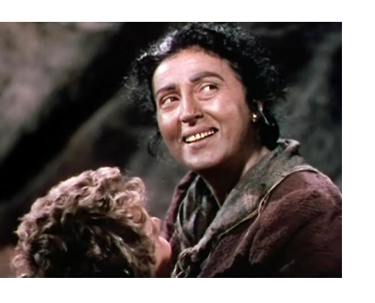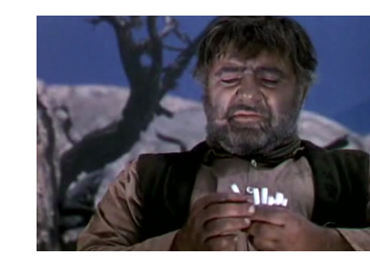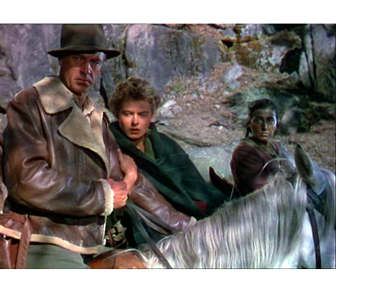
 |
|
|
|
All the time I was growing up, Ernest Hemingway was lionized as a great American author. Critics have been clawing at his reputation for decades yet his books remain entertaining, as are several of the movie adaptations. Frank Borzage's pre-Code A Farewell to Arms holds up as a moody attempt to capture Hemingway's tale of doomed romance; it gave great roles to Helen Hayes and Gary Cooper. Ten years later, in the middle of WW2, Hemingway's latest 'hot' novel was launched in a fury, with David O. Selznick, surely basking in his power as a mover and shaker after Gone With the Wind, angling to force Paramount into hiring his contractee Ingrid Bergman on his terms. He stage managed a meeting between Hemingway, Cooper and Bergman in the skiing resort of Sun Valley, and then slipped out publicity that the author deemed those actors his official choice for the movie version. Hemingway had even assured the Swedish Bergman that she could pass for a Spaniard. Paramount had Cooper under contract, but they tried to cut corners on this very expensive film (during wartime rationing!). Instead of Hemingway's preferred Ingrid Bergman, they filmed for a full three weeks with actress Vera Zorina in the coveted role of María. Bergman was truly miserable when she thought she'd lost the part, and instead took a part in a 'nothing' movie being made over at Warners... Casablanca. As it turned out, nobody on location was happy with Ms. Zorina. It's said that a cruel substitution took place. On a trip back to Hollywood, Zorina found out that Bergman, having finished Casablanca, was having her hair cut so she could hurry to the mountain location. 
For Whom the Bell Tolls was a powerhouse Road Show attraction in 1943, one with a controversial subject. The tragic Spanish Civil War had ended only four years before. Franco was sitting out WW2 as a neutral leaning toward Germany, and America was strongly divided on the issue. Some big critics like James Agee were incensed by the screenplay's attempt to downplay the political aspect of the book by blurring the official names of the combatants. Yet there is no question which side Hemingway's American hero Robert Jordan (Gary Cooper) is fighting for: the enemy, Franco's Army, wears German-style helmets. Hemingway may have been politically committed, but the sure-fire adventure story he came up with is easy to appreciate without a political message, which is probably why the critics were complaining. Volunteer soldier Robert Jordan lends his engineering skills to the Republicans, blowing up Franco's trains and bridges where needed. He's sent into the mountains to enlist a band of gypsies led by the murderous Pablo (Akim Tamiroff) to dynamite a strategic bridge at exactly the right moment during an attack. Jordan befriends the aged guide Anselmo (Vladimir Sokoloff) and Pablo's former woman, fiery gypsy guerilla Pilar (Katina Paxinou). The other gypsies (Arturo de Córdoba, Mikhail Rasumny, Fortunio Bonanova, Victor Varconi) are a selection of amusing and sentimental cutthroats. Rasumny in particular has an an ingratiating character and superb accent. Pilar and Jordan also solicit help from a neighboring village, in the person of chieftain El Sordo (Joseph Calleia). But the real prize for the Yankee is María (Ingrid Bergman), a young massacre survivor helped through the trauma by Pilar. Encamped in the rugged mountains, 'Roberto' and María become lovers. 
The wartime easing of censorship restrictions gave For Whom the Bell Tolls a generous boost in the excitement department. A minor scandal in the book, the 'sleeping bag scene' was a high point for the movie. The lovers are so gone on each other that Pilar runs down the hill laughing for them. It's easy to conclude that they are making love during every fade or discreet cutaway. Greek actress Katina Paxinou had been stranded in America when the war broke out. Her Pilar is nearly unforgettable, and she steals the film, hands down. Pilar considers herself an old crone but is so vital that she actually comes off as sexy as well. The camera loves her as much as it does Bergman -- the dawn of the final day is first seen on Pilar's face as she lies on a rock, waiting to begin a guerilla attack. The character seems capable of anything. Paxinou also won a best supporting Oscar for her work, the film's only win. Akim Tamiroff's marvelous Pablo is an ambivalent villain who resents Jordan's taking over the band of fighters. He tries to sabotage the explosives for the bridge. Even when Pablo undergoes a change of heart and joins the battle, he's a selfish and ruthless killer. Pilar's not sure he can be trusted. Tamiroff, Paxinou and Joseph Calleia became favorite actors for Orson Welles; they all get great, outsized characters to play. Vladimir Sokoloff is an old softie with a kind heart. Mikhail Rasumny's foolish gypsy hunts rabbits during a battle, and then risks too much to destroy a Fascist tank. Fortunio Bonanova (the Opera coach in Citizen Kane and the Opera fan in Kiss Me Deadly) has some good scenes as a maddeningly non-committal comrade. 
It's a Gary Cooper role, all right. The handsome and rugged actor is definitely a cowboy fighting for a cause. His dialogue states that he's fighting Fascists in Spain so he won't have to fight them at home, which may have been a way of absolving the character of communist ideology. Cooper conveys a clean line of Hemingway's macho-humanitarian masculinity, but he also adds in a dash of 'Cooper Cutes', pixie-ish Frank Capra moments where the normally sober Jordan breaks character to twinkle his eyes and flash boyish smiles and rub noses with María. It works, but those scenes tend to be isolated. In fact, the action stops more than once to allow Cooper and Bergman 'special' moments together. A couple of these appear to be awkward retakes, adjustments to up the romance quotient. Excepting a brief test for Intermezzo this is Ingrid Bergman's first film in color. A ragged head of short hair transforms her enough to take on the character of María, a coltish youngster learning hard lessons about life, love and war all over a few short days up in the Sierra de Guadarrama. Oddly enough, Bergman feared that she played María as 'too happy.' The Swedish actress is of course the number one reason to see the movie. She glows with life even without the addition of Technicolor. Cooper wisely gives her the spotlight. He hangs back with he-man poses and returns her girlish gushing with soulful, conflicted looks. 3 That's the acting fireworks. For Whom the Bell Tolls is also a pinnacle of a certain kind of Hollywood artifice. Sam Wood is the producer-director but the camera direction -- in terms of laying out the shots and designing the angles and compositions -- all seems to be in the hands of Production Designer William Cameron Menzies. The movie is designed down to the last detail of each shot, and almost every scene that's not a close-up or doesn't take place in a cave seems to be a special visual effect. Countless tight angles use matte paintings for part of the frame, often wedging a sliver of blue sky up in a corner somewhere. Elaborate scenes are designed almost as would be an animated film, sometimes with cheated perspectives: a flight of planes taking off; a train being dynamited; a convoy of trucks climbing switchback mountain roads. Menzies's mannered visuals monitor the 'emotional temperature' throughout. Cooper and Bergman and given many huge, choker close-ups with shallow focus that hold the glints on their eyes but not their ears. On a large screen the shots of Bergman emoting can be intoxicating. The nervous, trembling María seems ready to explode from the screen. 
Menzies' designs for the extended battle at the bridge are a tour-de-force of dynamic angles -- all needing mattes and miniatures to establish the right spatial relationship between various guard shacks, the attacking gypsies and a road down which advances a line of armored enemy vehicles. Cooper's stand-in climbing onto the superstructure of the bridge is a perfect match in long shots. We realize how much of the location is being faked when troops crossing the bridge partly disappear behind a matte line. Any composite effect in Technicolor had to be done in triplicate, which means that the effects men and lab experts must have put a factory system in effect to grind out all those near-perfect visual illusions. Menzies expresses his personal pictorial sense as well. Using the screen to create a sense of scale and height, the characters are often dwarfed by rocks and cliffs. Starting with Roberto's killing of his comrade Kashkin, Menzies uses the motif of a dark rock masking a big piece of the screen, to symbolize Death. As if foreshadowing their fates, key images of Roberto and María see them all but blocked off the screen by objects that obstruct our view. Once one is aware of these visual schemes, the movie begins to take on the dynamism of a good graphic novel. The way people are framed informs our understanding of them. Menzies' visual schemes 'apply pressure' to the characters. The matte effects and rear projections require that the film be mostly static images, which sometimes makes For Whom the Bell Tolls look like a sophisticated silent film, but in full Technicolor. Adding immeasurably is Victor Young's stirring, Spanish flavored romantic music score. The tense and exciting show put audiences through the wringer, both for action and emotions. The big bridge scene is followed by a 'moment of truth' situation that pushes the limit of dramatic contrivances - and succeeds. To escape, the fleeing guerillas must race their horses across a gap that for several seconds exposes them to enemy fire, as if in a shooting gallery. It's almost as ritualized as a bullfight, or a game of Russian Routlette. The way it's filmed, it seems unlikely that any of the guerillas could run the gauntlet without being hit. Thus we're set up for Hemingway's intense emotional finale. It's so overdone that it should be absurd, but the filmmakers and actors have prepared for it far too well. |
|||||||||||||||||||
Review Staff | About DVD Talk | Newsletter Subscribe | Join DVD Talk Forum
Copyright © MH Sub I, LLC dba Internet Brands. | Privacy Policy
Subscribe to DVDTalk's Newsletters
|